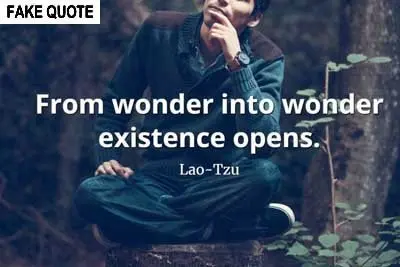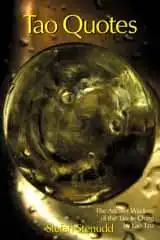Fake Lao Tzu Quote
"From wonder into wonder..."

This is NOT a quote from Tao Te Ching:
"From wonder into wonder existence opens."
The Book
The Taoism of Lao Tzu Explained. The great Taoist philosophy classic by Lao Tzu translated, and each of the 81 chapters extensively commented. Click the image to see the book at Amazon (paid link).
More about the book here.
|
Existence would be a strange word in the mouth of Lao Tzu. He used an ancient expression, the ten thousand things, which meant the whole world and everything in it. Existence implies the opposite of non-existence, and what would that be? Lao Tzu had no interest in something illusionary. He talked about reality as he saw it, and the conditions to which it was bound.
Wonder, on the other hand, is an expression he could relate to. He found so much in the workings of the world amazing, especially what he saw as everything's root: Tao, the Way. He frequently praised it in Tao Te Ching, calling it "the origin of all things" and yet it modestly "becomes one with the dust" (chapter 4, my version).
|
90 of the most spread false Lao Tzu quotes, why they are false and where they are really from. Book by Stefan Stenudd. Click the image to see the book at Amazon (paid link).
More about the book here.
|
In spite of the above, the quote examined here is actually from an interpretation of Tao Te Ching: the book The Way of Life According to Laotzu from 1944, by Witter Bynner. He called it "An American Version." The quote is from the end of chapter 1, but Bynner's version is quite distant from other translations.
In these lines, the relation between what Bynner calls the core and the surface is explained (page 25):
The core and the surface
Are essentially the same,
Words making them seem different
Only to express appearance.
If name be needed, wonder names them both:
From wonder into wonder
Existence opens.
Bynner's choice of "core" and "surface" is an interesting alternative to the usual translations. The former refers to Tao, the Way, and the latter to how it is expressed in the world. The chapter explains that you need to be free of desires to observe the former and full of desire to observe the latter.
I used "mystery" and "manifestations" for those two aspects of reality (earlier in the chapter). Here is my version of the same last lines:
These two have the same origin but differ in name.
That is the secret,
The secret of secrets,
The gate to all mysteries.
Arthur Waley in 1934 used "Secret Essences" and "Outcomes," ending the chapter (page 141):
These two things issued from the same mould, but nevertheless are different in name.
This 'same mould' we can but call the Mystery,
Or rather the 'Darker than any Mystery',
The Doorway whence issued all Secret Essences.
D. C. Lau in 1963 used "its secrets" and "its manifestations," where "it" is Tao. His ending of the chapter reads (page 57):
Being the same they are called mysteries,
Mystery upon mystery -
The gateway of the manifold secrets.
The complication with Bynner's version is the word "existence," especially since that was the term he used for Tao throughout his translation. It is a strange choice. According to Lao Tzu, Tao is the cause and ruler of existence, but not the same as it. How could something cause and rule itself?
What mystery or secret the gate opens to is indeed something unclear also after reading the following 80 chapters of Tao Te Ching. It might even be the essence of Tao — but it is not Tao itself, or Lao Tzu would just have used that word again, as he did three times in the opening line of that chapter, which is a play of words that Bynner's solution can't catch. Tao can be both a noun and a verb, so the line says: "The Tao that can be 'Taoed' is not the eternal Tao." In my version:
The Way that can be walked is not the eternal Way.
James Legge in 1891 stayed with not translating Tao, but was still able to point out the pun (page 47):
The Tâo that can be trodden is not the enduring and unchanging Tâo.
Bynner's beginning of the chapter misses that little joke. It reads:
Existence is beyond the power of words to define.
He should have been more careful with choosing his own words.
For more about Witter Bynner and his version of Tao Te Ching, see the chapter A man with outward courage.
Stefan Stenudd
September 14, 2020.
There are many more fake Lao Tzu quotes examined on this website.
Click the header to see a list of them.
Click the header to read a "fake" interview with Stefan Stenudd, the author of
Fake Lao Tzu Quotes.
My Taoism Books
Click the image to see the book at Amazon (paid link).
The Taoism of Lao Tzu Explained. The great Taoist philosophy classic by Lao Tzu translated, and each of the 81 chapters extensively commented.
More about the book here.
The Ancient Wisdom of the Tao Te Ching by Lao Tzu. 389 quotes from the foremost Taoist classic, divided into 51 prominent topics. Click the image to see the book at Amazon (paid link).
More about the book here.
Erroneous Tao Te Ching Citations Examined. 90 of the most spread false Lao Tzu quotes, why they are false and where they are really from. Click the image to see the book at Amazon (paid link).
More about the book here.
|
My Other Websites:
The 64 hexagrams of the Chinese classic
I Ching and what they mean in divination. Try it online for free.
The ancient Chinese life energy
qi (
chi) explained, with simple instructions on how to exercise it.
The many ancient and modern life force beliefs all over the world explained and compared.
Other Books by Stefan Stenudd
Click the image to see the book at Amazon (paid link).
The Greek philosophers and what they thought about cosmology, myth, and the gods.
The life energy
qi (also
chi or
ki) explained, with exercises on how to awaken, increase and use it.
Basic concepts of the peaceful martial art. Aikido principles, philosophy, and fundamental ideas.
Qi, prana, spirit, ruach, pneuma, and many other life forces around the world explained and compared.
Jungian theories on myth and religion examined, from Carl G. Jung to Jordan B. Peterson.
About me
I'm a Swedish author and aikido instructor. In addition to fiction, I've written books about Taoism and other East Asian traditions. I'm also an historian of ideas, researching ancient thought and mythology. Click the image to get to my personal website.

 Tao Te Ching
Tao Te Ching Now it's a book, too!
Now it's a book, too! Tao Quotes
Tao Quotes Cosmos of the Ancients
Cosmos of the Ancients Qi — Increase Your Life Energy
Qi — Increase Your Life Energy Aikido Principles
Aikido Principles Life Energy Encyclopedia
Life Energy Encyclopedia Archetypes of Mythology
Archetypes of Mythology Stefan Stenudd
Stefan Stenudd